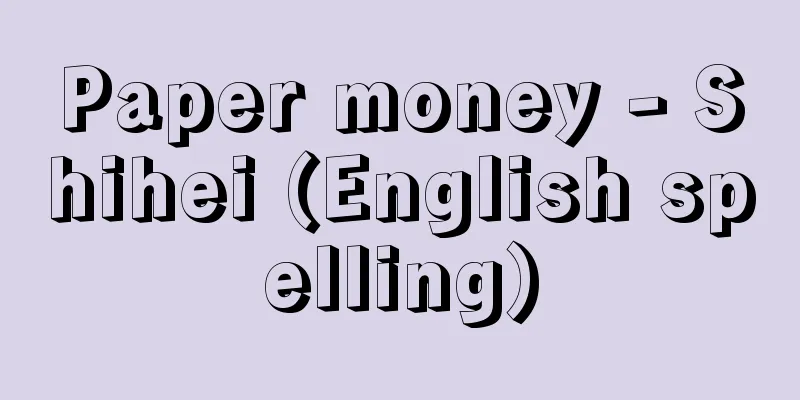Paper money - Shihei (English spelling)

|
Paper currency such as government notes and bank notes. Usually, the term government notes is used to distinguish between convertible bank notes, commercial bills, and checks, which are all credit currency, even though they are all paper money (paper currency). Paper money has a long history, and is said to have existed in China since the Han Dynasty, but it was not until the 18th and 19th centuries that it was fully issued by various governments. Some of the most representative paper currency in history are the assignat notes issued by the revolutionary government during the French Revolution, the so-called greenback notes during the American Civil War, and the currency notes issued by the British government during World War I. In Japan, there are the feudal domain notes from the Edo period, the Daijokan notes and new notes of the Meiji government, small denomination notes from World War I and from the Second Sino-Japanese War to World War II, and military notes from areas occupied by the Japanese military. Although there were some differences, the banknotes of each country generally had the following characteristics and functions: (1) There are two types of paper currency: convertible and inconvertible. Most paper currency either ends up being the latter or has been the latter since it was first issued. (2) Nevertheless, the direct basis for its exchange between people is that the state has given it legal tender status and made it legal tender. (3) Although they were sometimes issued as a substitute for subsidiary currency, most were issued as a means of resolving financial difficulties caused by war, etc. In such cases, the amount issued was determined not by the need for circulation but mainly by the degree of financial hardship. (4) Although they are directly put into circulation as a means of purchasing, because they are inconvertible paper currency, they cannot be recovered from circulation through conversion. Furthermore, even if they are returned to the issuer, the government, through the payment of taxes or the subscription of government bonds, unless fiscal spending is significantly tightened, they will be re-issued in excess of the amount returned, and will remain in circulation. As a result of the above, large-scale issuance of government paper money often led to a decline in the value of the paper money and inflation; the aforementioned Assinya and Greenback notes are famous examples of this. Furthermore, today's central bank notes are inconvertible bank notes, and like government notes, their excessive issuance (circulation) is not regulated by convertibility, and so they always have the potential to cause inflation. However, on the other hand, their issuance and redemption are carried out in a manner similar to that of convertible bank notes, so inflation also occurs within this issuance and redemption route. This is why central banks are strongly urged not to make policy mistakes. [Tadashi Saito] [Reference] | | | | | | | | |Source: Shogakukan Encyclopedia Nipponica About Encyclopedia Nipponica Information | Legend |
|
政府紙幣や銀行券などの紙製の貨幣。通常は、同じく紙幣(紙券貨幣(ペーパー・マネー))であっても、兌換(だかん)銀行券、商業手形、小切手などを信用貨幣として区別しているので政府紙幣をさして用いる。紙幣の歴史は古く、中国ではすでに漢の時代に存在していたといわれるが、各国政府によって本格的に発行されたのは18~19世紀である。史上代表的な紙幣としては、フランス革命時に革命政府が発行したアッシニャ紙幣assignat、アメリカ南北戦争時のいわゆるグリーンバック紙幣greenback、第一次世界大戦時にイギリス政府が発行したカレンシー・ノートcurrency noteなどがある。わが国では、江戸時代の藩札、明治政府の太政官(だじょうかん)札や新紙幣、第一次世界大戦時や、日中戦争から第二次世界大戦にかけての小額紙幣、日本軍占領地での軍票などがある。 各国の紙幣は、多少の差異はあっても一般的には次のような特質と機能を備えていた。 (1)紙幣には兌換紙幣と不換紙幣とがあるが、多くは結果的に後者であるか、発行当初から後者であった。 (2)それでも人々の間で授受される直接的根拠は、国家が強制通用力を付し、法貨としていることにある。 (3)補助貨幣の代用として発行される場合もあるが、多くは戦争などによる財政難を解決する一手段として発行された。この場合、発行額は流通の必要に応じて決まるのではなく、おもに財政困窮の度合いによって決まった。 (4)流通には購買手段として直接投下されるが、不換紙幣のため兌換による流通からの回収もなく、さらに租税の納入や国債応募によって発行者たる政府に還流しても、財政支出がよほど緊縮されない限り、還流額を超えてふたたび発行され、流通内に滞留することになった。 以上の結果、政府紙幣の大規模な発行は、しばしば紙幣価値の下落、インフレーションの原因となったが、前述のアッシニャ紙幣、グリーンバック紙幣はその例として有名である。 なお、今日の中央銀行券は不換銀行券であり、その過剰発行(流通)が兌換によって規制を受けていない点では政府紙幣と同じであり、つねにインフレーションを引き起こす可能性をもつ。しかし、他面でその発行・還収は兌換銀行券のそれとほぼ同様の形態によって行われることから、インフレーションもまたこの発行・還収のルートのなかで生ずることになる。中央銀行が政策上の錯誤をしないよう強く要請されるゆえんもここにある。 [齊藤 正] [参照項目] | | | | | | | | |出典 小学館 日本大百科全書(ニッポニカ)日本大百科全書(ニッポニカ)について 情報 | 凡例 |
<<: Autism - Jihei (English spelling) autism
Recommend
Stefan Permskii
Around 1345-96 A missionary and saint of the Russi...
Tower telescope - Tower telescope
A tower-shaped telescope used primarily for spectr...
Territorial church - Landeskirche [Germany]
An ecclesiastical system that emerged in the Germa...
Iobates
…After accidentally killing someone, he fled to A...
PSALI
...In addition to cove lighting, which illuminate...
Firefighting equipment - Firefighting equipment
The Fire Service Act (promulgated in 1948) collect...
Bournville
...Industrialists soon began to plan new towns th...
Ol'ga (English spelling)
Born: Around 890. Pskov Died in 969. Wife of Princ...
Senjuji Temple
[1] A Shinshu Takada-ha temple in Takada, Ninomiya...
Friedrich August von Hayek
Austrian economist and thinker. Hayek's achie...
Ilinx - Ilinx
…(3) Imitation (mimicry) - the play of trying to ...
book-seller (English spelling)
…Even before the printing era, there were booksto...
Mycetophilidae; fungus gnat; mushroom fly
A general term for insects belonging to the Dipter...
Dog hunting - Inuryou
…Until 1787, under Louis XVI, the Danish kings pr...
Strassburg
…Population: 256,000 (1990). German name: Strassb...









